The Global and American Companies Generating the Most Revenue Per Employee
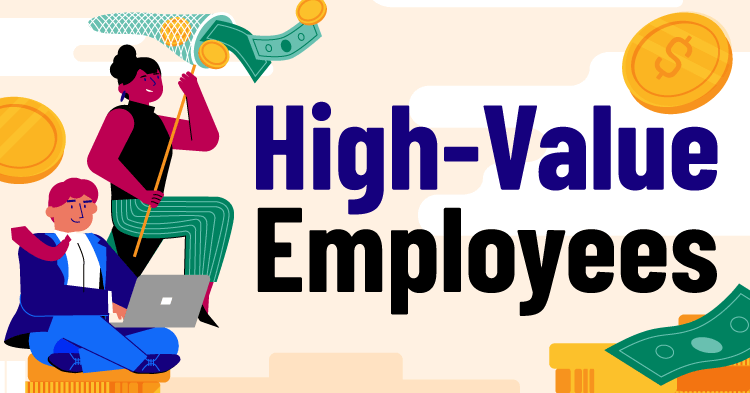
In a challenging moment for the economy, the U.S. has performed better than expected. According to J.P. Morgan, inflation is improving, and supply chains are almost realigned after the difficulties of the pandemic. Indeed, thanks to ‘lessons learned,’ supply chains are being restructured to better weather whatever lies ahead.
But uncertain times have forced companies to make difficult decisions about their employees — who are often the very fabric of a company. Between January and July of 2023, layoffs in the tech industry alone reached five figures every month. To complicate the picture, this has occurred during a labor shortage when firms in many industries have struggled to attract talent.
While companies don’t need to make millions of dollars per employee to consider themselves successful, calculating the revenue per employee has proven a useful tool for measuring a business’s performance across time or against competitors.
To grab a snapshot of the national and international business landscape right now, we ranked the world’s biggest publicly traded companies by how much revenue they generate per employee. Data analysts here at OnDeck analyzed employee count and annual revenue data from the Forbes’ Global 2000 list in order to rank these companies based on the average annual revenue per employee for this year.
Key Findings
- Rajesh Exports, an Indian consumer durables company, generates $292,074,074 per employee per year — the most of any company in the world.
- VICI Properties, a New York City financial company, generates $133,043,478 per employee — the most of any company in the U.S.
- Coinshares International, a U.K. asset management company, generates the most revenue per employee of any company in Europe ($28,222,222).
- Netflix is the big tech company that generates the most revenue per employee: $2,492,969 per year.
The U.S. Companies Generating the Most Revenue Per Employee
First, we focused on U.S. companies. The most profitable sector per employee is Oil & Gas Operations. Seven of the top 20 firms are in this sector, while a further three are categorized as Construction, Oil & Gas Operations, Mining and Chemicals. Oil and gas prices have soared since Russia invaded Ukraine, with some companies doubling their annual profits.
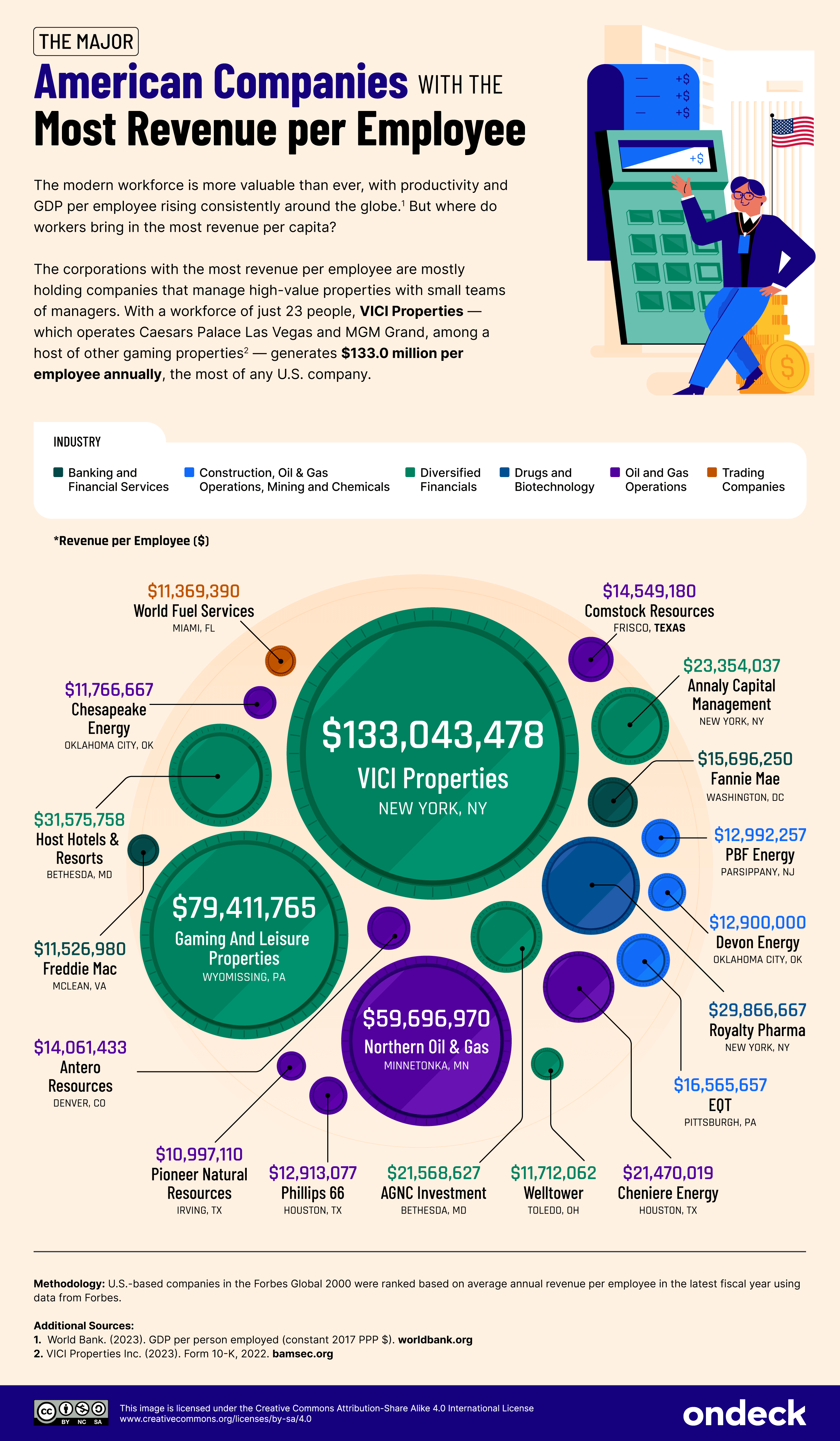
Click here to see the image in full size
Six of the 20 firms with the most revenue per employee are in the Diversified Financials sector. This includes the national number one: NYC firm VICI Properties.
The company employs just 23 people with annual revenue of just over $3 billion. VICI owns Caesars Palace Las Vegas, MGM Grand and the Venetian Resort Las Vegas, among hundreds of gaming and hospitality destinations, and has benefited from the “rebound” effect of the post-pandemic return to gaming. Since the company leases these properties to other companies, VICI profits grandly while maintaining a small staff.
Next, we looked closer at the most profitable companies across industries. The top retail company makes $1.6 m per employee annually: Murphy USA maintains over 1,700 gas stops and convenience stores, employing 15,100 people. As a “unique high-volume, low-cost business” business, Murphy can thank its ground-level employees for shifting a lot of a very expensive product: fuel.
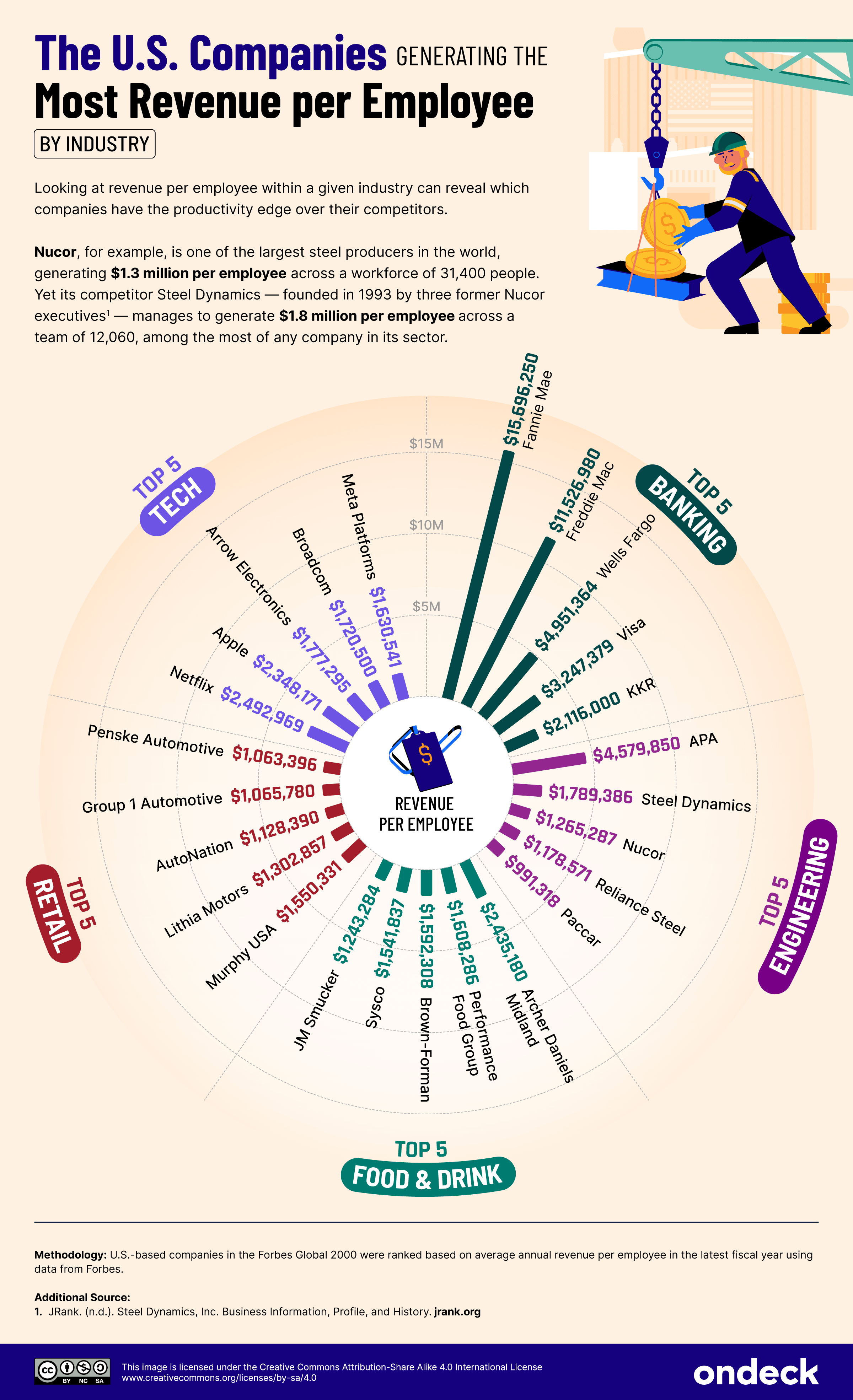
Click here to see the image in full size
One company that reaps high revenues per employee despite having a sizable workforce is Apple. With more than double the employees kept by Meta, Apple makes three times Meta’s revenue. Apple managed to lay off relatively few staff in the tech cull of 2023, benefitting from a more cautious approach to hiring in the first place.
“Apple has outperformed others and avoided the over-expansion we saw at some other tech firms during the pandemic period,” John Van Reenen, a professor at the London School of Economics, told Business Insider.
However, when we refocus on Big Tech companies — including those tech giants that Forbes doesn’t classify under its tech category — Netflix (Media & Advertising) takes the crown.
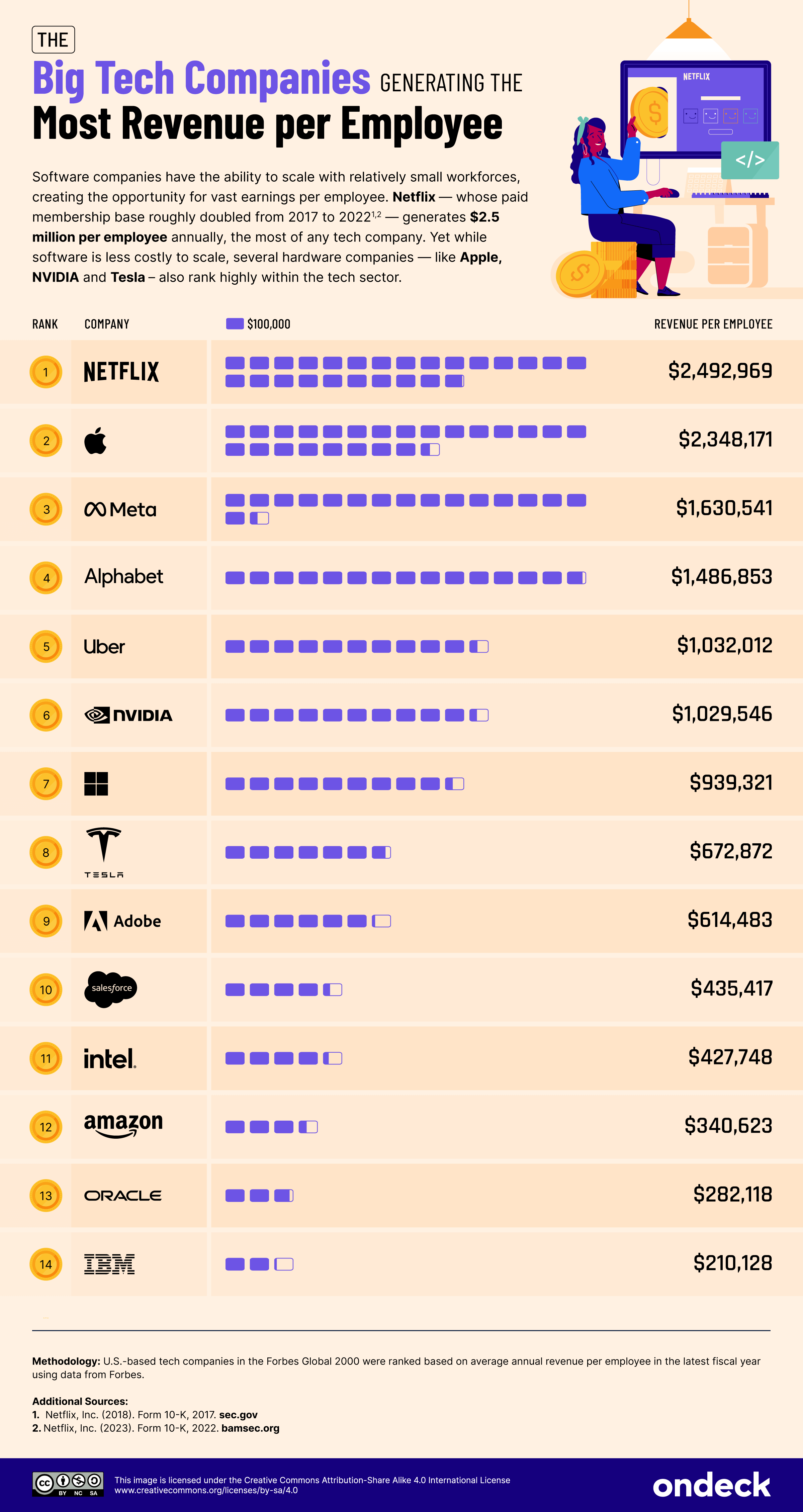
Click here to see the image in full size
Netflix retains the smallest staff of the 14 tech giants on our list. As the industry leader in a highly scalable industry, Netflix was able to scoop $31.6 billion in revenue from some 230.8 million global members in 2022 while maintaining just 12,800 employees — a figure that does not need to grow substantially in line with swelling profits. The profitability of Netflix is further thanks to a careful balance of original and acquired content, each of which has its advantages in terms of economic efficiency.
Next, we narrowed our focus to New York City companies. The national number one, VICI Properties, has the highest revenue per employee, leading a New York top 10 in which seven companies are finance-based, whether Diversified Financials or Banking and Financial Services.
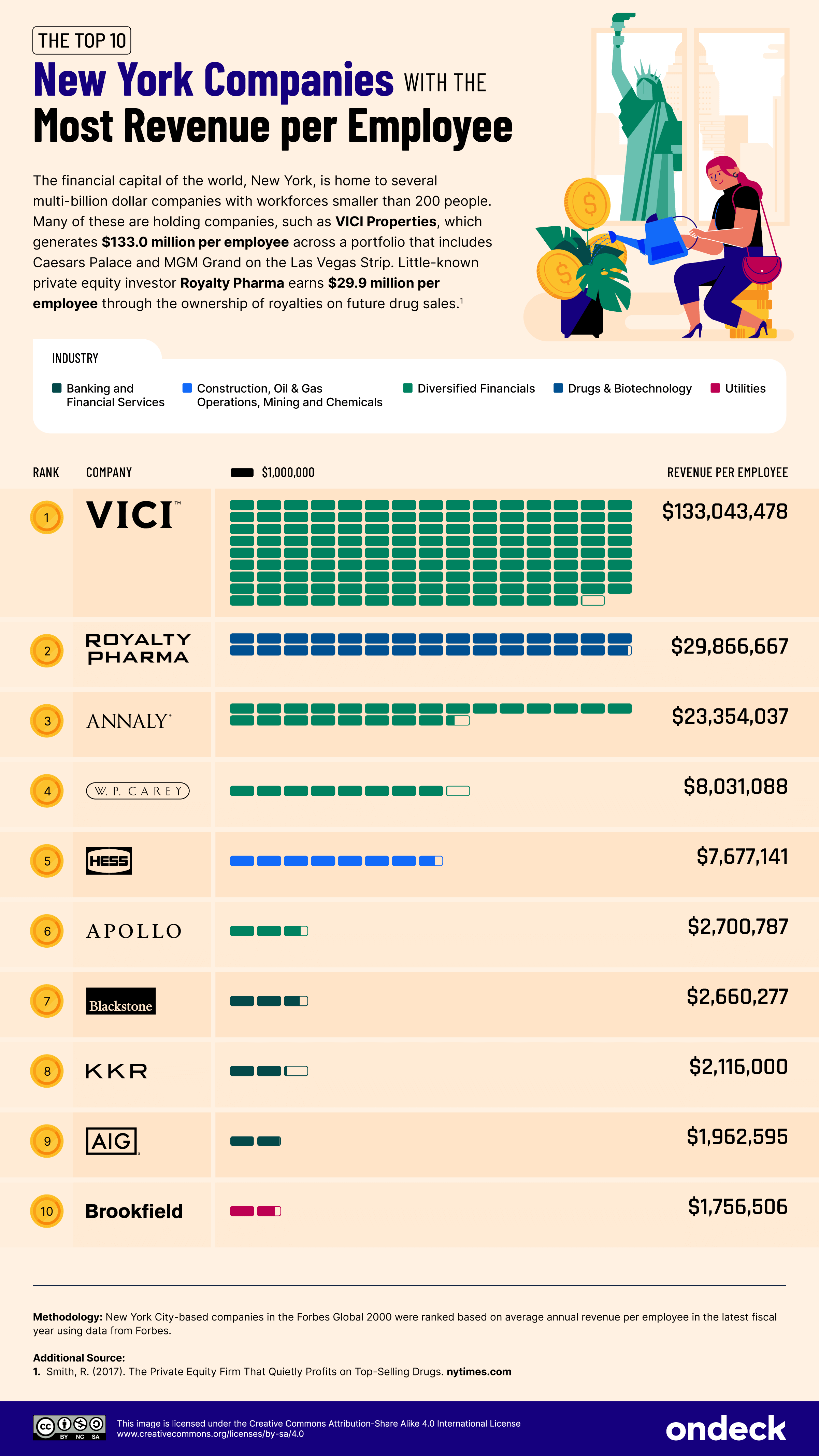
Click here to see the image in full size
The NYC company with the second-highest revenue per employee takes -77.55% less per employee than the number one, VICI. Royalty Pharma is a private equity investor that “buys up the rights to royalties on future drug sales,” according to the New York Times, and it “is run by a small cadre of staff members in Midtown Manhattan, deploying money from outside investors, including university endowments and wealthy individuals.”
The Global Companies Generating the Most Revenue Per Employee
On a global scale, U.S. firms account for 11 of the 20 that generate the most revenue per employee. India has three, Canada has two and the others are in China, South Korea, Japan and the U.K.
The industry with the most players in the top 20 is Diversified Financials (five), with Oil & Gas Operations accounting for three businesses — plus EQT, a company categorized under Construction, Oil & Gas Operations, Mining and Chemicals.
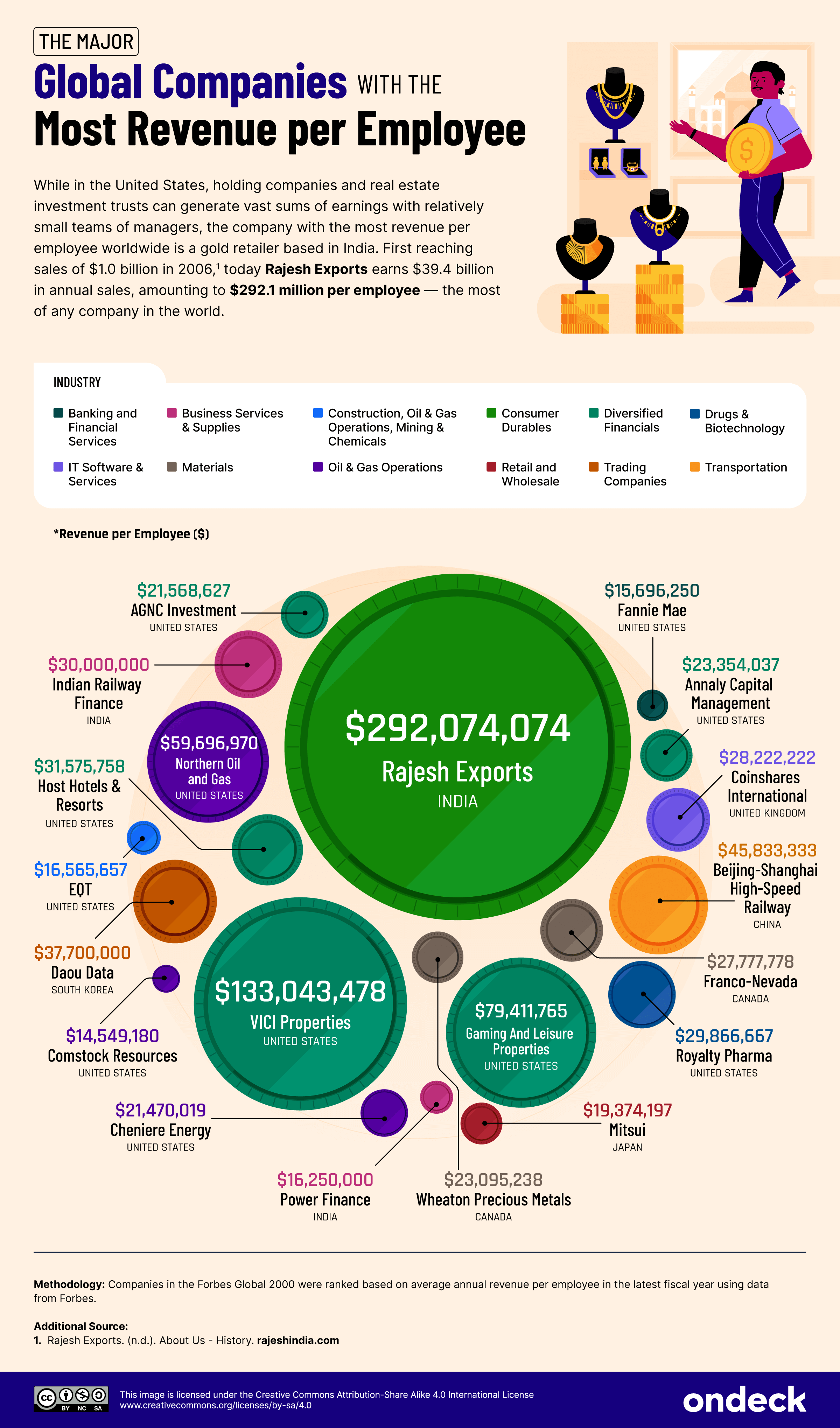
Click here to see the image in full size
An Indian company, Rajesh Exports, has the highest revenue per employee in the world, at $292 billion. This is 2.2 times as much per employee as second-placed VICI Properties. Rajesh Mehta got into business with a $120 loan to begin re-selling jewelry in 1982. He later established Rajesh Exports to manufacture and distribute gold jewelry; the company “mechanized manufacturing to cut costs to below 1%” and now claims to process 35% of the world’s gold production.
Next, we opened it out across the categories — and discovered that one company generates revenue of $3 billion with just 72 employees. China’s Beijing-Shanghai High-Speed Railway was established to build and operate the eponymous rail line and stations in 2007. Although the company reports a relatively low proportion of profit on that revenue, the company is still known as “the world’s most profitable high-speed rail.”
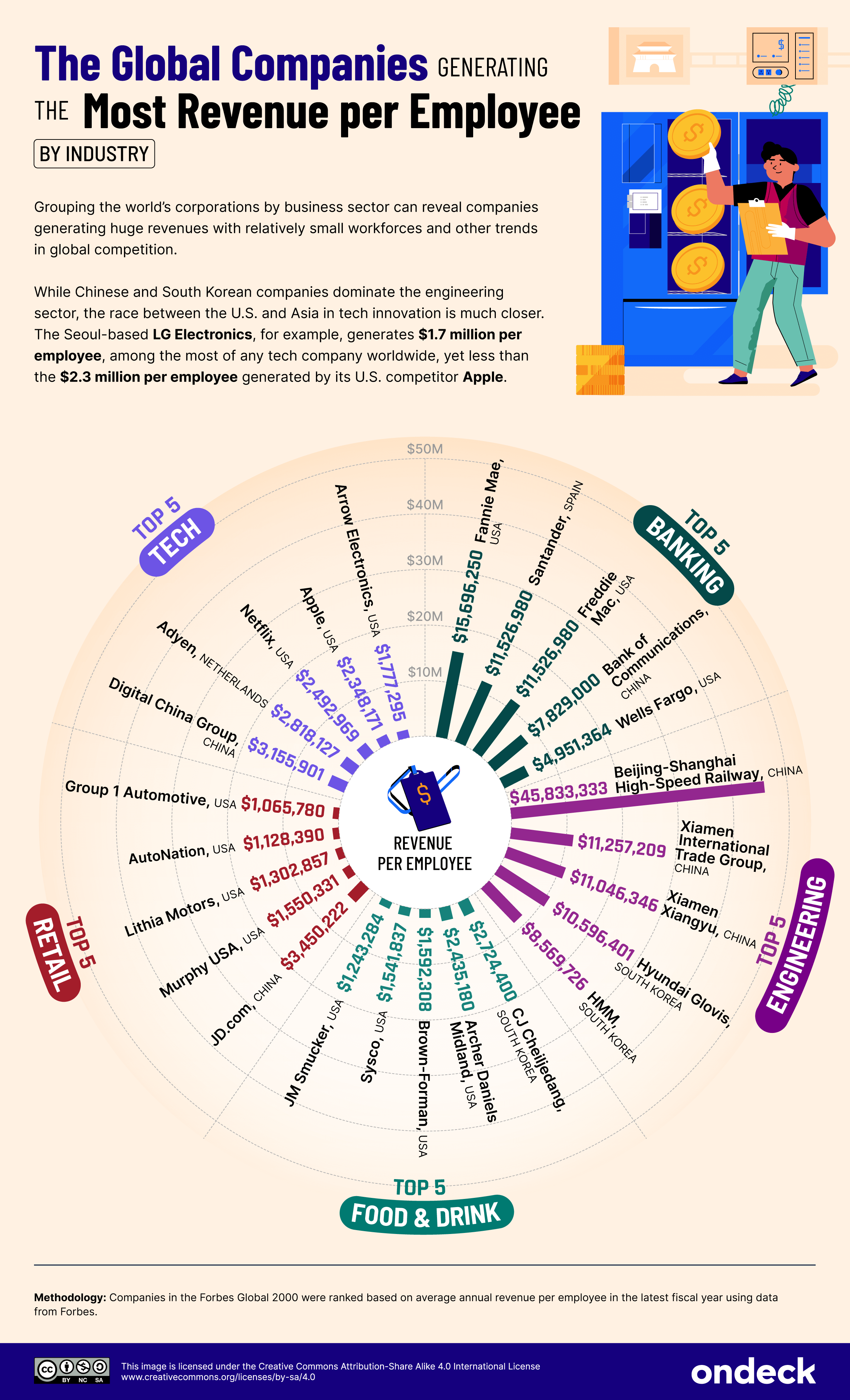
Click here to see the image in full size
The Dutch company Adyen is a payments platform business and rival to PayPal. The business’s revenues are up by over one-fifth year on year, although this figure is vastly lower than in previous years as Adyen’s stratospheric rise slows. But workforce-wise, CEO Ingo Uytdehaage is taking it in his stride: “We’ve added a lot of people, and it brought us to the next level of maturity,” he told Fortune. “[…]You need to have a certain size if you want to compete with companies that are 10,000 or 15,000 people. You can’t do that with 1,500 people, even if you’re super efficient, if you want to play on a global scale.”
However, Ayden doesn’t make our European top ten below. Energy firms of different sorts dominate the ranking, although the top two players are in tech and finance, respectively.
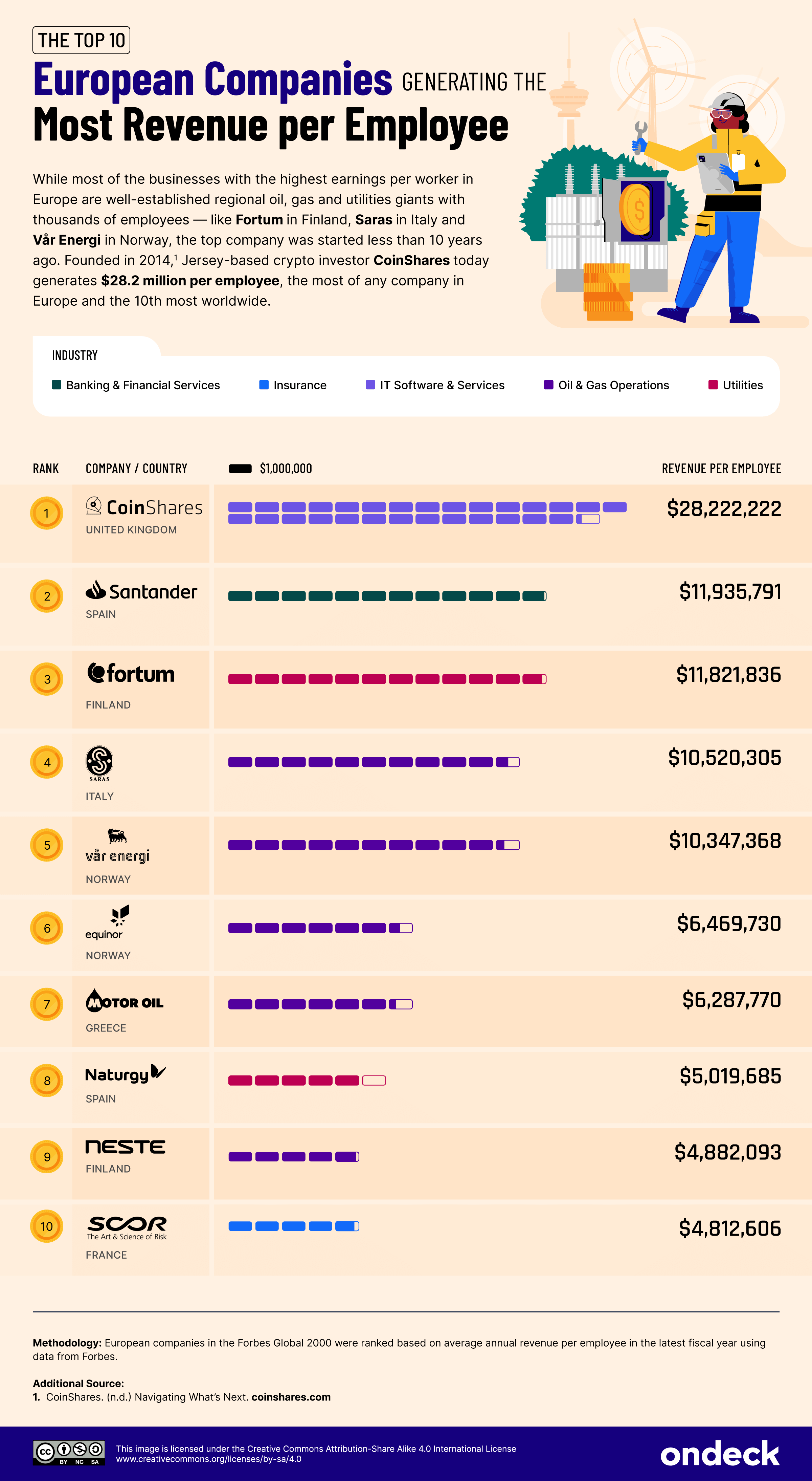
Click here to see the image in full size
The European company with the highest revenue per employee is Coinshares International. Coinshares is a Jersey-based U.K. asset management firm with just 90 people specializing in cryptocurrency and digital asset investments. The company debuted trading on Nasdaq Stockholm at the end of 2022, having weathered relatively minor damage from the FTX scandal.
Finally, we looked at the top Asian companies for revenue per employee. India’s Rajesh Exports and China’s Beijing-Shanghai High-Speed Railway are the top two, as detailed in the preceding paragraphs. But it is a diverse top ten, with four Indian companies, three Chinese, two from South Korea and one from Japan; no particular industry stands out.
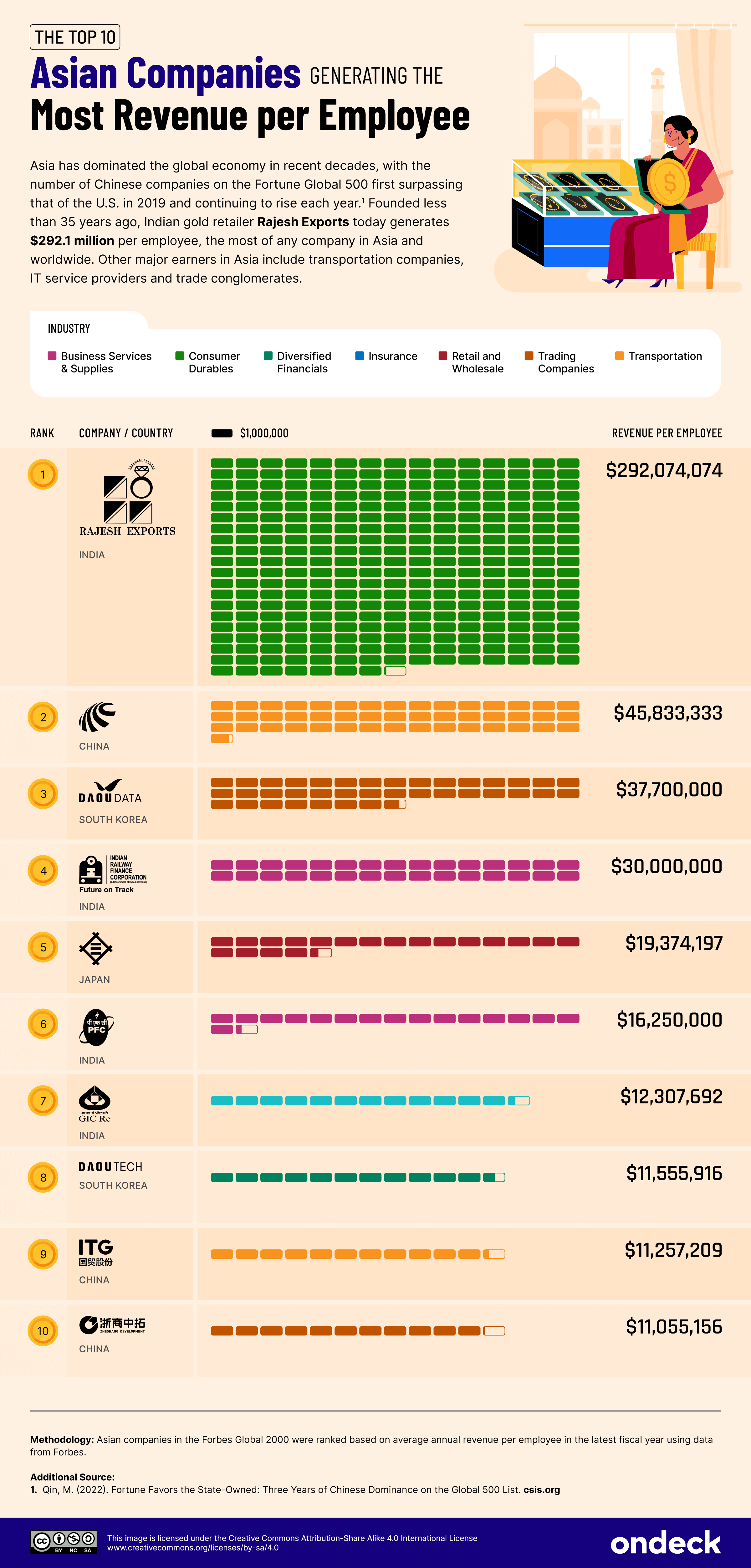
Click here to see the image in full size
The two South Korean companies in the chart are related. Both are affiliates of DaouKiwoom Group, which is known as the “first online and fast[est] growing securities company.” Daou Data offers business consultancy and payment solutions and has Asia’s fourth-best revenue:employee ratio. On the other hand, Daou Technology is a business software company; it has three times the employees of Daou Data and marginally lower revenue but still makes the Asian top ten with $11,555,916 in revenue per employee.
Final Thoughts
Revenue per employee is not an all-purpose metric: as some of the examples show, high revenue does not always indicate high profit. Neither does everybody involved get anything like an even cut — an important caveat when noting multi-million dollar revenues per employee! In this moment of massive energy costs, for example, the “median pay for an Exxon worker fell 9% last year to $171,582,” Reuters reports, “while Chevron’s median worker pay dropped 12%, to $161,488, filings showed.”
When assessing your own business’s health, then, it’s best not to be too wowed by other companies’ numbers. Factors, such as sales growth, earnings per share (EPS) growth, loyalty and satisfaction of both customers and employees, and the quality of the product or service you deliver, can all indicate how well your business is doing — and in what direction you should go next.
Methodology
To determine the public companies generating the most revenue per employee, we reviewed data from the Forbes Global 2000, which ranks the 2,000 largest companies in the world based on a weighted assessment of sales, profits, assets and market value. We sourced employee counts and annual revenue data from Forbes and ranked companies based on average annual revenue per employee in the latest fiscal year. OnDeck is not an affiliate, agent, or sponsor of any of the businesses mentioned herein.
Additional Sources
World Bank. (2023). GDP per person employed (constant 2017 PPP $). worldbank.org
VICI Properties Inc. (2023). Form 10-K, 2022. bamsec.org
JRank. (n.d.). Steel Dynamics, Inc. Business Information, Profile, and History. jrank.org
Netflix, Inc. (2018). Form 10-K, 2017. sec.gov
Netflix, Inc. (2023). Form 10-K, 2022. bamsec.org
Smith, R. (2017). The Private Equity Firm That Quietly Profits on Top-Selling Drugs. nytimes.com
Rajesh Exports. (n.d.). About Us – History. rajeshindia.com
Qin, M. (2022). Fortune Favors the State-Owned: Three Years of Chinese Dominance on the Global 500 List. csis.org
CoinShares. (n.d.) Navigating What’s Next. coinshares.com
DISCLAIMER: This content is for informational purposes only. OnDeck and its affiliates do not provide financial, legal, tax or accounting advice.
Find the right funding for your business.
Term loans up to $250K. Lines of credit up to $100K.
No obligations and no hard credit pulls.




